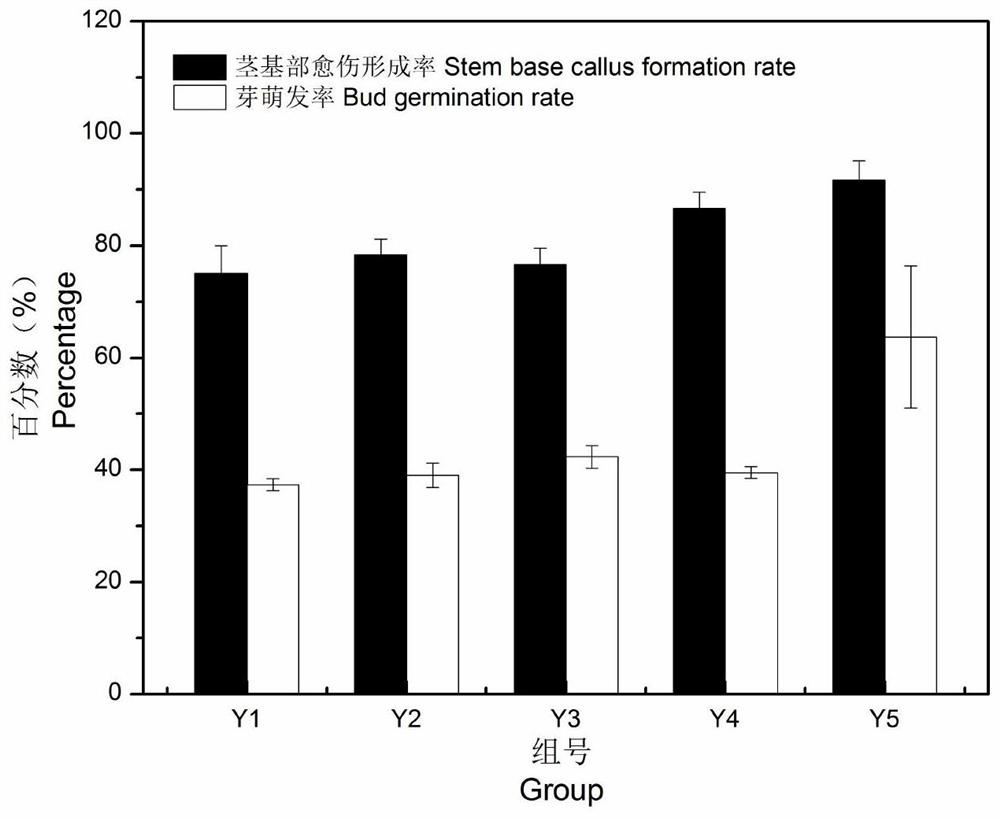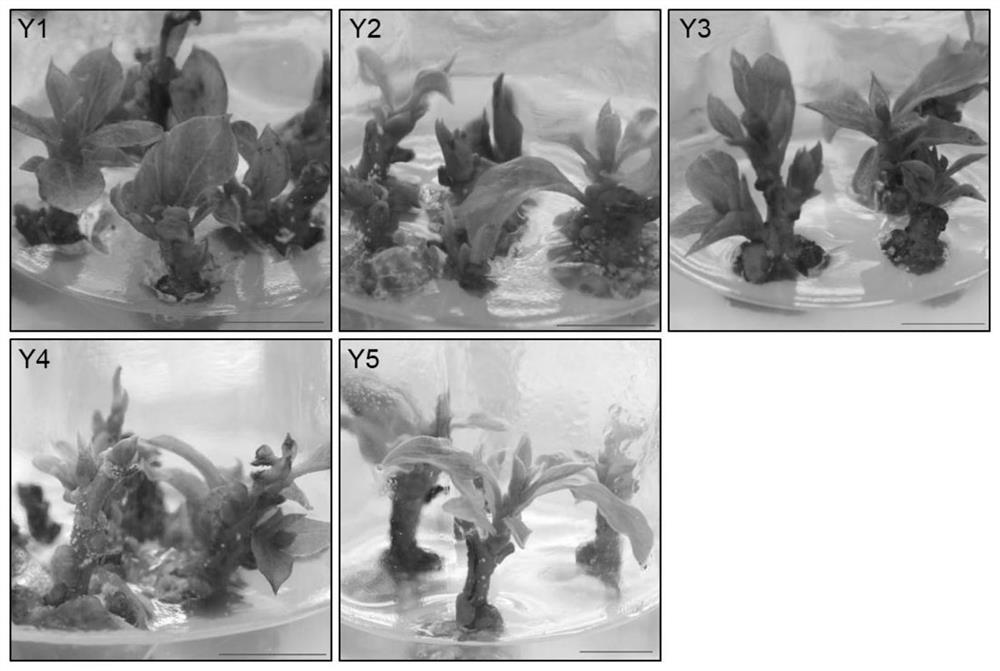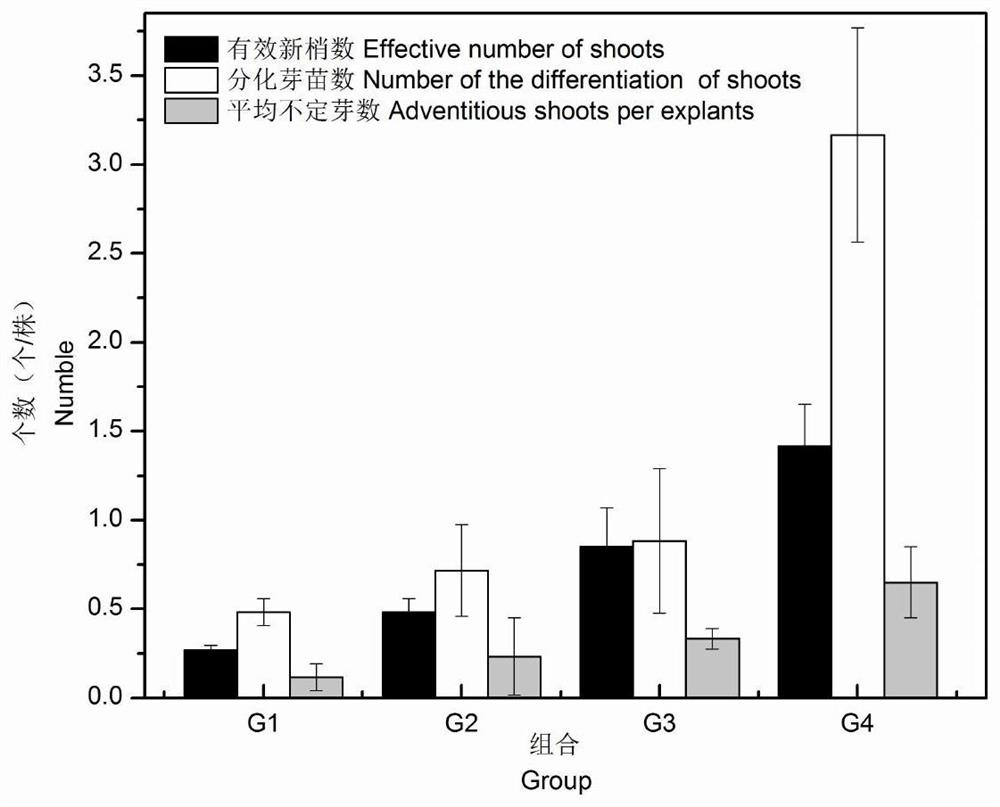Method for establishing in-vitro regeneration system of persimmons
A technology for in vitro regeneration and establishment of methods, which is applied in plant regeneration, horticultural methods, botany equipment and methods, etc. It can solve the problems of persimmon primary culture, subculture limitations, overgrowth, and hindering leaf growth, etc., to achieve healing The tissue is firm and light green, the germination rate is high, and the effect of easy extraction and growth
- Summary
- Abstract
- Description
- Claims
- Application Information
AI Technical Summary
Problems solved by technology
Method used
Image
Examples
Embodiment 1
[0040] (1) Establishment of the primary culture system
[0041] Take the tender stems of Yueyue persimmon that grow about 5cm in the same year, leave the petioles on the leaves on the tender stems, remove the leaves, rinse with running water for 60 minutes, put the stems into the sterilized Erlenmeyer flask in the ultra-clean workbench, and use 75 Sterilize the surface with 2% alcohol for 30 seconds, then soak it with 2% NaClO for 5 minutes, shake it constantly during the soaking process, and finally rinse it with sterile water for 5 times. The cleaned tender stems were cut into stem segments each containing 1 axillary bud, and finally inoculated on the corresponding primary culture medium. To verify the effects of different medium types and different ZT concentrations on the primary culture of the current year's young shoots of persimmon. Each combination was inoculated with 20 stem segments and repeated three times. After 30 days, the callus formation rate and bud germinat...
Embodiment 2
[0052] (1) Establishment of subculture proliferation culture system
[0053] The aseptic tissue culture seedling that primary generation culture obtains is cut into the stem segment that contains 2 axillary buds and is about 1cm long, and then inoculates in the corresponding subculture propagation medium. To verify the effects of different medium types, different plant growth regulators ZT, IAA and their concentrations on the subculture of persimmon seedlings. Each combination was inoculated with 20 stem segments and repeated three times. After 30 days, the average number of differentiated shoots, the number of effective new shoots, and the number of differentiated adventitious buds were counted. Wherein the number of effective new shoots is the tender shoots that are higher than 1cm and can be used for subculture, the number of adventitious bud differentiation is the number of buds formed on the callus at the base of the subculture seedlings, and the number of differentiated...
Embodiment 3
[0066] (1) Callus induction and adventitious bud regeneration from detached leaves
[0067] Take the leaves of subcultured 25-30d seedlings 'Moon Persimmon' tissue culture seedlings as explants, cut across the middle of the leaf and divide them into petiole and leaf tip, with the back of the leaf facing upward, and inoculate into the corresponding medium . To verify the effects of different medium types, different plant growth regulators ZT, TDZ and concentrations on the callus induction and adventitious bud regeneration of the detached leaves of 'Yue persimmon'. Each combination was inoculated with 50 leaves and repeated three times. Cultivate for 20 days, then light culture, and count the rate of leaf callus formation after 30 days. Adventitious bud regeneration adopts the secondary induction method, inoculating the induced callus into the adventitious bud differentiation medium, subcultured once every 20 days during this period, and counting the adventitious bud regenerat...
PUM
 Login to View More
Login to View More Abstract
Description
Claims
Application Information
 Login to View More
Login to View More - R&D
- Intellectual Property
- Life Sciences
- Materials
- Tech Scout
- Unparalleled Data Quality
- Higher Quality Content
- 60% Fewer Hallucinations
Browse by: Latest US Patents, China's latest patents, Technical Efficacy Thesaurus, Application Domain, Technology Topic, Popular Technical Reports.
© 2025 PatSnap. All rights reserved.Legal|Privacy policy|Modern Slavery Act Transparency Statement|Sitemap|About US| Contact US: help@patsnap.com



